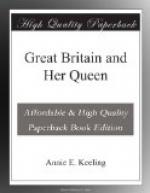[Illustration: Charles Dickens. From a Photograph by Elliott & Fry.]
[Illustration: W.M. Thackeray. From a Drawing by Samuel Lawrence.]
This nobler tone is not least perceptible in the eldest of the great masters of fiction whom we can claim for our period—Dickens, who in 1837 first won by his “Pickwick Papers” that astonishing popularity which continued widening until his death; Thackeray, who in that year was working more obscurely, having not yet found a congenial field in the humorous chronicle that reflects for us so much of the Victorian age, for Punch was not started till 1841, and Thackeray’s first great masterpiece of pathos and satire, “Vanity Fair,” did not begin to appear till five years later. Each of these writers in his own way held “the mirror up” to English human nature, and showed “the very age and body of the time his form and pressure,” with manly boldness indeed, but with due artistic reticence also; each knew how to be vivid without being vicious, to be realistic without being revolting; and despite the sometimes offensive caricature in which the one indulged, despite the seeming cynicism of the other their influence must be pronounced healthy. Thackeray did not, like Dickens, use his pen against particular glaring abuses of the time, nor insist on the special virtues that bloom amid the poor and lowly; but he attacked valiantly the crying sins of society in all time—the mammon-worship and the mercilessness, the false pretences and the fraud—and never failed to uphold for admiration and imitation “whatsoever things are true, whatsoever things are honourable, whatsoever things are just, whatsoever thing are pure, whatsoever things are lovely.” And though both writers were sometimes hard on the professors of religion, neither failed in reverence of tone when religion itself was concerned.
[Illustration: Charlotte Bronte.]
The sudden death of both these men, in the very prime of life and in the fulness of power, was keenly felt at the time: each had a world-wide fame, and each awakened a blank, distressful sense of personal loss in his many admirers as he was suddenly called away from incomplete work and faithful friendship. Contemporary literature has not benefited by the removal of these two men and the gradual diminishing of the influence they so strongly exerted while yet they “stood up and spoke.” The work of Charlotte Bronte—produced under a fervent admiration for “the satirist of Vanity Fair,” whom she deemed “the first social regenerator of his day”—is, with all its occasional morbidness of sensitive feeling, far more bracing in moral tone, more inspiring in its scorn of baseness and glorifying of goodness, than is the work of recent Positivist emulators of the achievements of George Eliot. Some romances of this school are vivid and highly finished pictures of human misery, unredeemed by hope, and hardly brightened by occasional gleams




